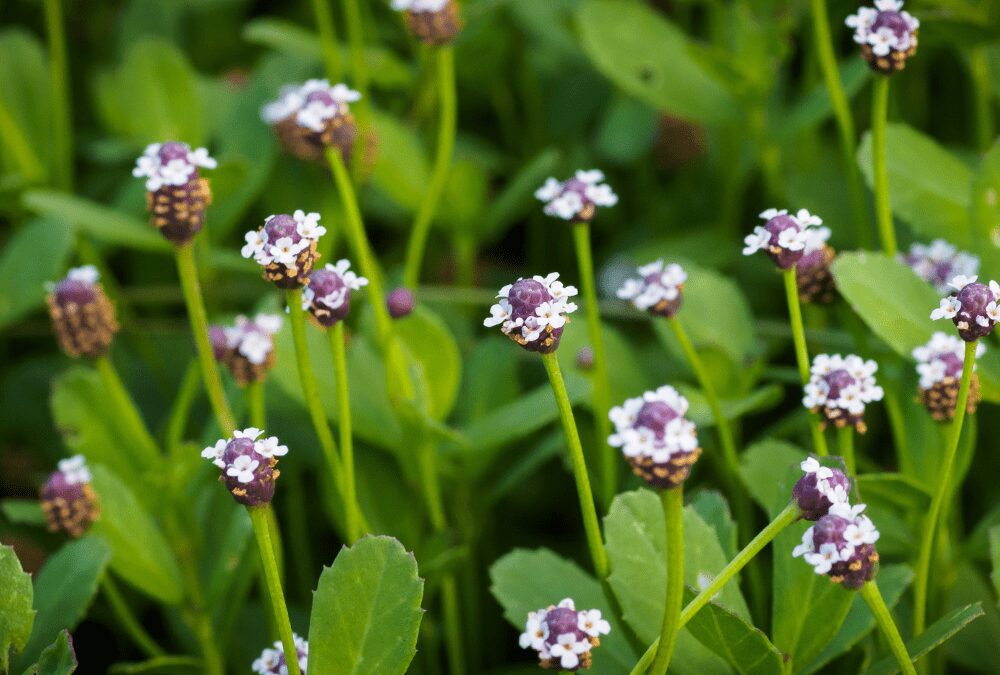I have a groundcover that I am just in love with. It not only has an adorable name, it also seems to be content growing almost anywhere. Frog Fruit is the name and replacing turf is its game. While this groundcover will look best with regular watering, it can also tolerate heat, drought, AND periods of flooding. Not particular to soil type, Frog Fruit will also be content in shade, dappled shade, part shade, or full sun. I just love an adaptable plant!


About Frog Fruit Groundcover
Frog Fruit, Phyla nodiflora, is a cheerful looking groundcover that only grows to heights of about 4-8 inches but stretches its legs up to 4 feet! That’s literally some serious ‘groundcover’! Spacing recommendation is still about 1 to 1 ½ feet, and that is most likely because when it comes to groundcovers there is that rule: 1st year they sleep, 2nd year they creep and 3rd year they leap. Get it? They generally take awhile to get going.
Frog Fruit is generally evergreen here in San Antonio where our winters are somewhat mild. Green leaves take on a reddish/purplish tinge through the cold. If we have a hard winter, Frog Fruit will go dormant but return when warm weather arrives in spring.


From spring to fall, tiny, verbena-like flowers appear, offering nectar to an abundance of pollinators. Frog Fruit is a native Texas groundcover that is also a host plant to Common Buckeye, Phaon Cresecentspot and White Peacock butterflies and offers nectar to an abundance of pollinators with its multitude of tiny, clustered blooms. Flowers are whitish pink, with a deep fuchsia/brown center. While they are small (1/2 inch heads), they appear for three seasons, beginning late spring and blooming into fall.
Frog Fruit has a sprawling, trailing habit and looks quite charming when planted in containers as the ‘spiller’ feature in plant arrangements, planted towards the edges of the pots. It looks just as charming when it spills over rock borders and rock walls.


There is one notable warning when it comes to Frog Fruit and that is that you should NOT mow it back until AFTER it stops flowering. For some reason this causes enough stress to it that it can take years to recover from. I don’t know why you would really need to mow it back anyways, but this is your warning.
Ok, maybe I have one more warning for you. The word is getting out on this adorable groundcover so if you see it at the nursery and you want it, you should go ahead and buy it.
I hope you fall in love with Frog Fruit as much as I have. I bet you do.
~The Happy Gardener, Lisa Mulroy


Is there anything edible or medicinal about Frog Fruit?
Hi Debbie,
Good question. I did not know myself, but researched a little bit and it looks like it has multiple medicinal properties. I would do as much research as possible, but here is a site I found interesting.
Does this plant self-sow or otherwise reseed itself such that I have to worry about it jumping (no pun intended) into adjacent beds or neighbor’s lawns?
HI Stephen,
I like the pun, intended or not. The seeds are not the issue, but it does spread rapidly by rhizomes, so if you are trying to keep it contained, you’d probably want to use some edging.
Is it deer resistant?
Hi Judith,
It IS! just remember to always take that with a grain of salt. No plant is truly deer proof! Here is our deer resistant groundcover list to see some other options as well.
I was all excited about trying this in my backyard until I read that frog fruit is toxic to dogs.
Hi Tami,
Good on you for doing research if you have a pup that tends to chew and eat plants. I’ve seen one citing that states this, although it is not listed on the ASPCA toxic plant list. It’s always good for pet owners that also love plants to double check the toxicity levels. Thanks for the info.
I have kids and am looking for a drought resistant ground cover. Is it good for bare feet?
Hi Sarah.
It doesn’t have stickers or thorns, but it is not particularly trample proof. Is the are you want to plant sun or shade? Blue Star Creeper or Creeping Thyme are drought tolerant once established, but we generally get those type of “steppable groundcovers” in springtime.
Where can you find seeds for this stuff? I can only find plugs.
A google search took me to a listing on Amazon.